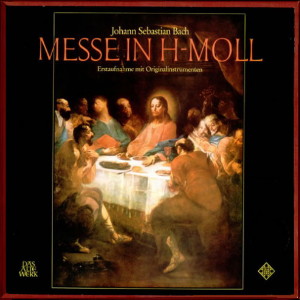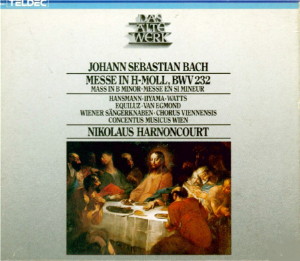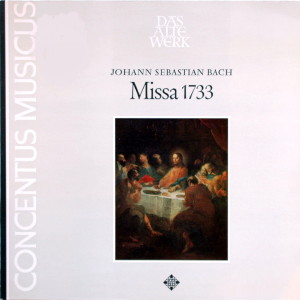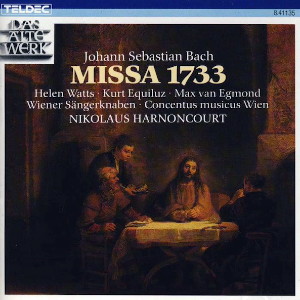 |
3 LP -
SKH 20/1-3 - (p) 1968
|

|
| 2 CD -
8.35019 ZA - (c) 1984 |
 |
| 1 LP -
SAWT 9581-B - (p) 1972 |
 |
| 1 CD -
8.41135 ZK - (c) 1986 |
|
Johann
Sebastian Bach (1685-1750)
|
|
|
|
|
|
|
|
|
|
| Messe in h-moll, BWV 232 |
|
|
|
|
|
|
|
|
|
| Kyrie |
|
|
17' 42" |
|
- Kyrie eleison
|
* |
8' 42"
|
|
A1 |
- Christe eleison
|
* |
5' 59"
|
|
A2 |
- Kyrie eleison
|
* |
3' 01"
|
|
A3 |
| Gloria |
|
|
36' 15" |
|
- Gloria in excelsis Deo
|
* |
1' 52"
|
|
A4 |
- Et in terra pax
|
* |
4' 40"
|
|
A5 |
| - Laudamus te |
* |
4' 40"
|
|
B1 |
- Gratias agimus tibi
|
* |
2' 53"
|
|
B2 |
- Domine Deus
|
* |
5' 48"
|
|
B3 |
- Qui tollis
|
* |
2' 29"
|
|
B4 |
- Qui sedes
|
* |
5' 03"
|
|
B5 |
| - Quoniam tu solus |
* |
4' 32"
|
|
C1 |
- Cum Sancto Spiritu
|
* |
4' 18"
|
|
C2 |
| Credo |
|
|
30' 21" |
|
- Credo in unum Deum
|
|
2' 08" |
|
C3 |
- Patrem omnipotentem
|
|
2' 05" |
|
C4 |
- Et in unum Dominum
|
|
5' 37" |
|
C5 |
| - Et incarnatus est |
|
2' 40" |
|
D1 |
- Crucifixus
|
|
2' 21" |
|
D2 |
- Et resurrexit
|
|
4' 19" |
|
D3 |
- Et in Spiritum
|
|
5' 22" |
|
D4 |
- Confiteor
|
|
3' 33" |
|
D5 |
- Et expecto
|
|
2' 16" |
|
D6 |
| Sanctus |
|
|
4' 48" |
|
- Sanctus
|
|
4' 48" |
|
E1 |
Osanna, Benedicstus,
Agnus Dei et Dona nobis pacem
|
|
|
17' 12" |
|
| - Osanna |
|
2' 52" |
|
E2 |
| - Benedictus |
|
6' 31" |
|
E3 |
- Agnus Dei
|
|
4' 47" |
|
E4 |
- Dona nobis pacem
|
|
3' 02" |
|
E5 |
|
|
|
|
|
| Rotraud Hansmann,
Soprano I |
|
Emiko Iiyama,
Soprano II
|
|
Helen Watts,
Alto
|
|
| Kurt Equiluz,
Tenor |
|
| Max van Egmond,
Bass |
|
|
|
| Wiener
Sängerknaben - Chorus
Viennensis / Hans
Gillesberger, Leitung |
|
|
|
Concentus Musicus Wien (mit
Originalinstrumenten)
|
|
| - Joseph Spindler,
Richard Rudolf, Hermann Schober,
Clarino |
|
| - Kurt Hammer,
Pauken |
|
| - Ernst Mühlbacher,
Naturhorn |
|
| - Leopols Stastny,
Gottfried Hechtl, Traverflöte |
|
- Jürg Schaeftlein,
Karl Gruber, Bernhard Klebel,
Oboe d'amore
|
|
| - Otto Fleischmann,
Milan Turkovič, Fagott |
|
- Alice Harnoncourt,
Klaus Maetzl, Peter Schoberwalter,
Stefan Plott, Violine
|
|
- Walter Pfeiffer,
Josef de Sordi, Wilhelm Mergl,
Ferdinand Svatek, Violine
|
|
- Kurt Theiner,
Clynn Barrus, Viola
|
|
- Nikolaus
Harnoncourt, Elli Kubizek,
Violoncello
|
|
- Eduard Hruza,
Violone
|
|
- Herbert Tachezi,
Orgel
(Truhenorgel)
|
|
|
|
| Nikolaus
Harnoncourt, Leitung |
|
|
Luogo e data
di registrazione
|
| Johann-Strauß-Saal, Casino
Zögernitz, Vienna (Austria) - aprile e
maggio 1968 |
|
Registrazione
live / studio
|
| studio |
Producer / Engineer
|
| Wolf Erichson |
Prima Edizione
CD
|
Teldec "Das Alte Werk" -
8.35019 ZA - (2 cd) - 54' 11" + 52' 39"
- (c) 1984 - AAD
Teldec "Das Alte Werk" -
8.41135 ZK - (1 cd) - 54' 08" - (c) 1986
- AAD *
|
Prima
Edizione LP
|
Telefunken "Das Alte Werk" -
SKH 20/1-3 - (3 lp) - 45' 21" + 39' 11"
+ 22' 00" - (p) 1968
Telefunken "Das Alte Werk" -
SAWT 9581-B - (1 lp) - 54' 08" - (p)
1972 *
|
| Nota |
| Con riferimento alla "Missa
1733", nelle sue parti Kyrie e Gloria
(Sawt 9581-B), si tratta della medesima
registrazione della Messe in h-moll (Skh
20/1-3). |
|
|
Notes
|
A Short History
of Interpretation pf the Mass in B
minor
Little
is known about Bach’s own performances
of the \vork. We can safely assume
that he never performed it as a whole.
The theory put forward in reccent
times (Smend) that we are not dealing
with a self-contained work at all, but
with a random collection of four
complete works for Lutheran services
that Bach gathered together in one
volume, we cannot subscribe to in this
radical form. The fourth part,
“Osanna, Benedictus, Agnus Dei et Dona
nobis pacein" would have no plausible
place in the Lutheran service; as
music during the distribution of
Communion (according to Spitta and
Smend) it would seem to us completely
unsuitable on account of its expensive
and festive orchestration (with double
choir, timpani and trumpets). It was
undoubtedly at a late stage probably
during the last years of Bach’s life,
before the work, whose individual
sections were composed at large
intervals, was compiled into a whole.
We cannot believe in a mere chance
that, of all things, a complete Latin
Mass in the correct sequence and most
consistent in the performing forces
and key used was "collected" in this
score, particularly in view of the
reappearance of the Gratias
from the Gloria in the Dona
nobis pacem, which can only be
interpreted as an intentional binding
together of the whole work. Working on
the same bases as Smend, Georg von
Dadelsen arrives at a result that
underlines the works unity. Bach
completed the score of the B minor
Mass in the years around
1746-1748, in the very period in which
he wrote his great cyclical works The
Art of Fugue and The
Musical Offering. The
incorporation of works already
composed into this score (Sanctus),
and its extension into a complete Mass
through the adaptation of other
suitable compositions, can most
readily be explained by the assumption
that Bach, beside his passions and
other great cycles, wanted to leave to
posterity a big Latin mass. Did Bach
the orthodox Lutheran then create a
super-denominational or even
"Catholic" Mass? For Bach this was by
no means as inconceivable as people
liked to regard it in Iater times.
After all, in the dedicatory preface
to the Missa he had written to
the Catholic King Augustus Ill; "...I
offer in humhlest oherlicnce, whenever
Your Royal Highness demands, ... to
prove my untiring industry ...in the
composition of church music..."
- in other words ooffered him the
composition of Catholic church music.
With regard to the performance of
parts of the Mass and their
composition, Smend's arguments are
entirely convincing. The Missa,
i.e. the Kyrie and Gloria,
for instance, as probably first
performed on 21st April 1733, the
occasion being the oath of fealty for
the new Elector of Saxony following
the death of Augustus the Strong. For
this ceremony Bach composed the work.
The "Symbolum Nicenum", the Credo,
may well have been (again according to
Smend) composed for the festive
rererication of the rebuilt St.
Thoma's School on 5th June 1732; the Sanctus
(according to G. v. Dadelsen) was
first performed at Christmas 1724. The
movements that follow, Osanna,
Beneditus, Agnus Dei and Dona
nobis pacem, are without
exception re-arrangements of older
compositions, incorporated into the
complete colume together with the Sanctus
when Bach prepared the complete
manuscript in the last years of his
life.
After Bach's death the bound score
came into the possession of his son
Philipp Emanuel, who performed the Credo
in 1786, thus about forty years later,
though considerably re-arranging and
"modernizing" it. He introduced a
large number of legato slurs, altered
the text distribution, put in dynamic
markings and altered the
instrumentation - above all by
omitting the oboe parts written colla
parte. These changes were to
adapt the work to the taste of the
time. From 1811 the Berlin
Singakademie began to study the work
in its rehearsals. In 1816 the Kyrie
and the Gloria were performed
at Kiesewetter's home in Vienna, in
1827 the Et incarnatus est in
Berlin, in 1828 the Credo and
in subsequent years also the Kyrie
and Gloria in Frankfurt, again
in 1828 part of the Credo in
Berlin (by Spontini). Large sections
of the Mass were first performed by
Rungenhagen with the Berlin
Singakademie in 1834. The first
performance (translated into German)
of the entire work took place in 1959,
thus more than a century after it was
written, under Riedel in Leipzig.
All these performances presented the
work in a greatly modified form with
specially composed introductions and
completely altered instrumentation.
The choruses were sung by at least a
hundred singers. Spontini had an
orchestra of twelve first and second
violins each, twelve violas, twelve
cellos and eight double-basses; in the
wind section there were clarinets,
horns and bassons but no trumpets and
oboes! Similar forces, both with
regard to the number of performers
(170 to 200 people) and to the
instrumentation were to he found in
all performances of that time - Bach
clothed in Beethoven’s sound, Basing
itself on these performances, there
subsequently arose the actual
tradition of interpretation of this
monumental choral work, which has
continued down to the present day. The
most serious interferences with Bach's
score have indeed been rectified but
the total impression has remained that
of a colossal choral work full of
onormous difficulties. The best
performances had, and still have, a
gigantic quality about them. From this
aspect, the work seems to us to have
been exhausted, so that a new
beginning must now be made. We must
return to the starting point, to
Bach's musical and intellectual
conception and sound quality.
Nikolaus
Harnoncourt (1968)
----------
Missa 1733
The research
that has gone into his life and
works over the last few decades
has caused us constantly to
revise our ideas of Johann
Sebastian Bach. Few works reveal
this constant revision more
clearly than his Mass in B
minor. Past generations have
referred to this work as Bachßs
"High Mass" seeing in it a
counterpart to Beethoven’s Missa
solemnis. It was Friedrich Smend
(“Neue Bach-Ausgabe,” 1954) who
first pointed out that each of
the four sections - the Missa,
the Credo, the Sanctus and the
concluding movements - had its
own individual significance,
having been created separately,
and that the arrangement in no
way corresponded to the
customary form of the Ordinary
of the Mass. Georg von Dadelsen
finally proved that about
fifteen years elapsed between
Bach’s composing the “Missa” (a
Short Mass consisting of “Kyrie”
and “Gloria”) in the year 1733
and his completion of the whole
work, even taking into account
his frequent use of earlier
compositions.
The “Missa”
the nucleus of the work, could
be performed both at a Lutheran
service and at the Catholic
court of Dresden. On July 27th,
1733, Bach dedicated the “Missa”
to the Elector of Saxony,
enclosing a petition to his
Royal Highness for the title of
Court Capellmeister, and, if the
suppositions of numerous music
historians are correct, had
allready performed the
composition on April 21st, 1722,
in the Leipzig Nikolaikirche on
the occasion of the Electors
official visit to the city after
succeeding King Frederic
Augustus II of Poland.
In the “Missa,” too, Bach
borrowed much material from
other compositions. However, in
this work we can find important
details that clearly distinguish
it from his cantatas and
oratorios. In the first place
there are no recitatives and
ariosos. Further, the composer
chooses not to use the
conventional da-capo aria form,
preferring merely to hint at a
repeat, or to build up the arias
form a series of sections. And,
finally, the work as a whole is
dominated by the choruses, which
are allocated the largest
portion of the work and, as a
result, bear the weight of the
whole musical structure.
Right at the start, the opening
of the “Kyrie” makes an impact
upon the listener. The form of
the opening movement is
conventional, a short chordal
tutti followed by an extensive
fugue; Bach`s treatment of it,
however, reveals the uniqueness
of his genius, the themes of the
“Kyrie” fugues are two of the
most glorious ever conceived.
The variety of styles is also
remarkable. The second “Kyrie”
and the “Gratias agimus tibi”
are both written in the “stilo
antico,” in contrast to the
“modern” style of the lively,
concertante choruses “Gloria in
excelsis Deo” and “Cum Sancto
Spiritu” with their figurations
full of runs and arpeggios.
Somewhere between the two
extremes we have the first
“Kyrie” and the “Qui tollis
pecata mundi.” The vocal solos
are all concertante in style,
although by no means uniform.
The “Laudamus te” aria is highly
ornamental with much florid
coloratura. The “Quoniam tu
solus sanctus” aria with the
horn’s wide intervallic leaps is
an impressive representation of
divine power. The setting of
“Christe eleison” and “Domine
Deus” as duets may also be
regarded as symbolic. They both
deal with Christ, the Son of the
Father, the second
section of the creed.
Bath had to wait another three
years before he actually
received the revered title of
Court Capellmeister, which he
hoped would bring him more
respect from the local Leipzig
authorities. We may monder
Whether the Elector ever
realized how immeasurably his
musical assets had increased
with his acquisition of the
“Missa.”
Alfred
Dürr
|
|
Nikolaus
Harnoncourt (1929-2016)
|

|

|
|